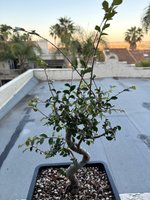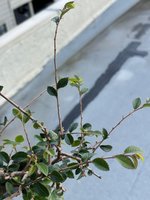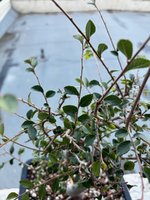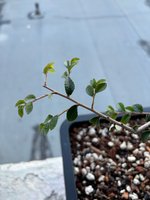zeejet
Yamadori
I recently noticed that my Chinese elm has started dropping leaves after a quick spring burst of growth. The dead foliage looks like it's starting to yellow and has black splotches.
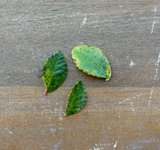
I suspect black spot fungus but I've seen it presented in two ways from photos online - either the fungus looks like it's growing on the surface of the leaf, or it looks to be developing within the leaf (like in my case). Can it be both?
I was also considering a trunk chop on this tree before this happened. Something tells me I should wait and try to heal the tree first, but the trunk chop would also remove a lot of the infected foliage. What should I do?
Additionally, I bought a cutting grown starter Prunus mume hybrid (mother tree was from a WB Clarke seedling that was open pollinated - sold by Brent Walston at Evergreen Gardenworks as Prunus mume x). It arrived with swiss cheese holes in a lot of the foliage already and recently developed these rust spots on healthy foliage as well.
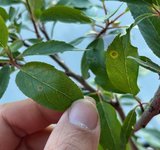
Again, I'm speculating that this is rust spot fungus, but not sure as I'm still only in my first year of growing bonsai and this is these are the first obvious signs of potential disease I've ever encountered.
I already sprayed both of these trees with Bio-Advanced (Bayer) 3-in-1 pesticide, but that didn't seem to prevent these trees from being infected.
Any advice would be greatly appreciated.

I suspect black spot fungus but I've seen it presented in two ways from photos online - either the fungus looks like it's growing on the surface of the leaf, or it looks to be developing within the leaf (like in my case). Can it be both?
I was also considering a trunk chop on this tree before this happened. Something tells me I should wait and try to heal the tree first, but the trunk chop would also remove a lot of the infected foliage. What should I do?
Additionally, I bought a cutting grown starter Prunus mume hybrid (mother tree was from a WB Clarke seedling that was open pollinated - sold by Brent Walston at Evergreen Gardenworks as Prunus mume x). It arrived with swiss cheese holes in a lot of the foliage already and recently developed these rust spots on healthy foliage as well.

Again, I'm speculating that this is rust spot fungus, but not sure as I'm still only in my first year of growing bonsai and this is these are the first obvious signs of potential disease I've ever encountered.
I already sprayed both of these trees with Bio-Advanced (Bayer) 3-in-1 pesticide, but that didn't seem to prevent these trees from being infected.
Any advice would be greatly appreciated.
Last edited:

